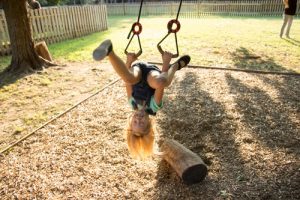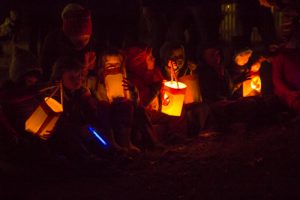By Acacia Moore, faculty-in-residence and a lead kindergarten teacher at the Rose Rock School in Norman, Oklahoma
I spent hours up in the trees as a child. Climbing as high as I could possibly manage, I would step out as far as I could while still holding onto something. The branch beneath my feet would rock as I stepped out to its thinner parts, but I enjoyed the unsteadiness, the constant rocking. Sometimes it was a calm and gentle sway that made me smile and close my eyes. A sudden strong gust would send me to the thrilling edge of fear, but I would rarely back down. I could really breathe up there.
I’m sure many of you can relate to my experience as a child. Or, perhaps, little me reminds you of a child in your care. Similarly, many of us can relate to the joy of a “water baby” –the child who can spend every day of summer in the water and still not tire of it. They are just two examples of how children seem to connect so deeply to nature through one of the four elements. Yet each one of the four elements–earth, air, fire and water–uniquely offers something nourishing to all of us. This is why it’s important to provide children with ample opportunity to play or spend time with each element.
In my LifeWays training, Mary O’Connell presented my class with a way to use the Four Elements as a lens of evaluation of the care we provide. Using this lens ensures that we at Rose Rock School (RRS) are providing a balanced and diversified experience for the children in our care that helps each of them connect intimately with nature and spirit. Below, I have included some simple ways we incorporate the four elements into outdoor time at Rose Rock.
Earth:
I hear it more than anything else when new people come to the school, “Wow! Look at the dirt hills!” The dirt hills seem like a nostalgic piece of “back when I was a kid” history that brings parents back to the beloved dirt digging of their own childhoods. The children are equally thrilled to have these two large dirt hills in the backyard. There, one can find small children digging, filling buckets, or just lounging in a bottom-sized hole. The bigger children orchestrate tunnel-building projects and go “dirt biking.”
While involving children in gardening is no new concept, it’s an essential component of LifeWays and of RRS. Watching the children dig their hands into the soil and ask when it will be their turn to plant a seed, pull a weed or harvest a tasty morsel, it’s easy to see why. Children who are new to Rose Rock and hardly eat a bite of veggies are often found begging for another snap pea or little okra plucked right off the plant once midsummer arrives. The manifestations of our work from garden to table are unmatched by any other natural process when it comes to showing children the great dependency we have upon nature and how worthy it is of our reverence. Be the bounty a bushel or a handful, the connection is made when they are involved.
Air:
In Oklahoma, and many places in the Midwest, it’s a given to experience windy days– but the catch is how to deepen the connection. Often we may only make off-hand comments–“Gosh, it’s a windy day”–and move on. However, we deepen the children’s connection to the element of air when we instead bring their attention to it as we watch the dust fly, noting how everything is blowing about the yard. A couple weeks ago, at the request of one of the “big kids,” we took out some cardboard scraps, yarn and scissors. With these few materials the big and little ones spent the entire day making their own airplanes and kites. For days after we watched their joy and delight as the kites picked up and lifted off into the air as the children ran, tossing their heads back to watch, too. In the fall we enjoy a similar wondrous experience when the helicopter seeds come whirling about the front yard in their own kite-like dances. Just taking pause to observe with children sets the stage for those little ones who like to experience this element.
 Windy day or not, the children feel the freedom of the skies when climbing trees. Or they feel it in the whirl of gravity and wind as they break through the air on the swings and acrobatic rings. Perhaps overlooked as a connection to the air, these outdoor toys are an easy connection constantly in use here at Rose Rock.
Windy day or not, the children feel the freedom of the skies when climbing trees. Or they feel it in the whirl of gravity and wind as they break through the air on the swings and acrobatic rings. Perhaps overlooked as a connection to the air, these outdoor toys are an easy connection constantly in use here at Rose Rock.
Water:
In the hot summer sun we all wish we could hop in a pool to laze about the rest of our day, every day. With 25 children, however, it’s not the most practical play opportunity for every day. Instead, we have a designated water day to play with water squirters and the baby pool. The anticipation builds through the week, and the children are thrilled when finally chasing each other around the yard with them.
Throughout the rest of the week we’re constantly watering gardens, allowing a spray or two to go awry, welcomed with a squeal of delight and “do it again!” We have a supply of watering cans always available for the children to help and sometimes pull out buckets of water and washcloths to bathe the dirty toys. We also refresh ourselves with juicy summer fruits and vegetables, like watermelons and cucumbers, maybe mentioning how thirsty that plant must have been while in the garden.
Fire:
The heat of the summer sun’s fire can feel rather oppressive come July through September. But it’s easy to highlight the benefits of so much light when our gardens– both vegetable and flower–come to life so vividly. Last year our marigolds exploded into the thousands. We were dead-heading until we were dead tired of having them around! But as the summer progressed we collected much of what we pulled and froze them. Then in September, we extracted a dye from our collection and dyed golden capes on our back patio to be passed out and valiantly worn at our Michaelmas festival.
A couple months later, when we are really feeling the cold nights creep in, we light a bonfire for Martinmas and gather around to share the warmth as a way to kick off a season of festivals celebrating the Light within.  Previously-made lanterns are passed out as we sing seasonal songs and walk together, watching the glow and glimmer before us and behind us, encircling the property. Thank you’s and good night’s are whispered, the little lights disappear and families disperse from the cold night air back to their cars and cozy homes.
Previously-made lanterns are passed out as we sing seasonal songs and walk together, watching the glow and glimmer before us and behind us, encircling the property. Thank you’s and good night’s are whispered, the little lights disappear and families disperse from the cold night air back to their cars and cozy homes.
Recently, two of my colleagues attended a local workshop about children and nature. They sat for six hours inside an over-air conditioned room under fluorescent lights, literally steps away from a nature trail and lake, going over a curriculum that outlines how to thoughtfully plan and arrange each moment the children spend outside. The workshop providers had wonderful intentions, no doubt, but a relationship with nature can’t be forced, and cultivating it doesn’t have to be so complicated. While crafts and discussions can be lovely additions to the experience of actual outdoor play, they are mostly more appropriate for an older child. It’s much more important for young children to connect with nature first-hand, through many unbridled and intimate experiences. As with all relationships, it takes time well spent to find a personal connection, and for that we adults need to get out of the way. As care providers here at RRS, we do our best to simply present opportunities for the children, and then, to let go and allow.
Acacia Moore has been working with children of all ages for 15 years  through public and private schools, and home-based care. Since the summer of 2013 she has been faculty-in-residence and a lead kindergarten teacher at the Rose Rock School in Norman, Oklahoma where she lives with her husband and three sons. She has worked with the teachings of Rudolf Steiner for the past 7 years and completed her LifeWays Early Childhood Certification in October 2016.
through public and private schools, and home-based care. Since the summer of 2013 she has been faculty-in-residence and a lead kindergarten teacher at the Rose Rock School in Norman, Oklahoma where she lives with her husband and three sons. She has worked with the teachings of Rudolf Steiner for the past 7 years and completed her LifeWays Early Childhood Certification in October 2016.